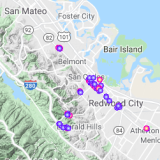
Skeleton weed is a California Department of Food and Agriculture (CDFA) A-rated noxious weed. A noxious weed is one that CDFA designates as troublesome, aggressive, intrusive, detrimental, or destructive to agriculture or important native species. Skeleton weed possesses these qualities because it can outcompete agricultural crops and native species for water and nutrients. As a result, the presence of this weed often reduces field crop yield and reduces forage for livestock.
Identification
Characteristics: Wiry stems and skeleton-like appearance
Rosette: 2-5 inch leaves, irregular teeth, lobes point backward
Flower: less than 1 inch
Full Grown Plant: up to 3 feet tall
Bolting: very few narrow linear leaves
Stem: characteristic bristly, downward pointing hairs at base of stem

Biology
Skeleton weed is a perennial weed endemic to Southern Europe and Eurasia. It flowers between June through late fall and self-fertilizes. It reproduces vegetatively from root fragments and disperses its seeds by wind.
Location
Skeleton weed is found in pastures, rangeland, roadsides, open and disturbed areas. Much of the skeleton weed in San Mateo county seems to have come from along the Caltrain tracks. It can be found between Atherton and San Mateo, as well as at the Edgewood Park and 280 interchange. However, most of the plants are now on private property.

Treatment Options
Hand pulling has its limitations because of the long tap root and the difficulty of pulling when the weed is growing in cracks in cement. However, pulling before seeds have a chance to develop and spread will reduce the populations. Systemic herbicides are better because the herbicide is transmitted down into the root, and control is more assured. Several products have been proven to be effective as long as they are combined with a surfactant to help penetrate the waxy plant surface. Treatments made to the rosettes in spring, or later in the fall will work best. Bio-agents will not eradicate Skeleton weed, but they can reduce seed production and stunt its grow reducing competitions with desirable plants. Rust fungus, gall mites, and a gall midges have all been released in various locations in our county, While these controls are working somewhat, they have not been enough to really diminish populations.